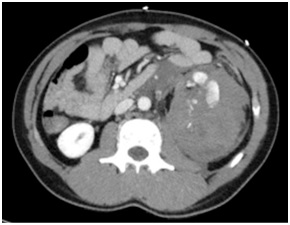Management of blunt renal trauma in a tertiary hospital of south India: a retrospective single centre study
Abstract
Background: Blunt renal trauma are usually caused by high-energy collisions such as road traffic accidents (RTA), fall from a height. They occur in 5 to 10 % of all trauma. Majority of hemodynamically stable patients with blunt renal trauma are successfully managed non operatively.
Aims and Objective: To review the management of blunt renal trauma in our centre.
Materials and Methods: A retrospective study of 22 patients was carried out in JSS Medical College and Hospital from January 2017 to January 2019. All blunt renal injuries were graded according to American Association for the Surgery of Trauma (AAST) organ injury severity scale. The following data were collected: demographics, mechanism of injury, associated injuries, admission hemoglobin, blood transfusion, CT findings, renal injury grade, presence of other organ injuries on CT scan, type of management, indication for operative intervention, operative procedures, operative findings, any other interventions required, hospital stay, morbidity, and mortality.
Results: There were 22 renal injuries. Majority of them had Road Traffic Accidents and assault. Grade 2-3 were most common in 12 cases followed by grade 1 in five cases, grade 4 in three cases and finally grade 5 renal injury was seen in three cases. Three grade 5 injuries and two Grade 4 needed exploration for hemodynamic unstability and underwent emergency nephrectomy otherwise all cases were managed successful nonoperatively. There was no mortality due to blunt renal trauma.
Conclusion: Conservative management of blunt renal trauma without associated abdominal injury is feasible in patients who are hemodynamically stable at presentation. Advancements in imaging techniques and improved critical care have favoured the conservative approach for even the severe grade of injuries.
Downloads
References
2. Martínez-Piñeiro L, Djakovic N, Plas E, et al. EAU Guidelines on Urethral Trauma. Eur Urol. 2010 May;57(5):791-803. doi: 10.1016/j.eururo.2010.01.013. Epub 2010 Jan 20.[pubmed]
3. Victorian State Trauma Outcomes Registry (VSTOR) Victoria, Australia: Department of Human Services;
4. Kuo RL, Eachempati SR, Makhuli MJ, Reed RL., 2nd Factors affecting management and outcome in blunt renal injury. World J Surg. 2002;26:416–419. [pubmed]
5. Santucci RA, Fisher MB. The literature increasingly supports expectant (conservative) management of renal trauma--a systematic review. J Trauma. 2005 Aug;59(2):493-503.[pubmed]
6. Broghammer JA, Fisher MB, Santucci RA. Conservative management of renal trauma: a review. Urology. 2007 Oct;70(4):623-9.[pubmed]
7. McGuire J, Bultitude MF, Davis P, et al. Predictors of outcome for blunt high grade renal injury treated with conservative intent. J Urol. 2011 Jan;185(1):187-91. doi: 10.1016/j.juro.2010.08.085. Epub 2010 Nov 13.[pubmed]
8. Chow SJ, Thompson KJ, Hartman JF, Wright ML. A 10-year review of blunt renal artery injuries at an urban level I trauma centre. Injury. 2009;40:844–850.
9. Massive transfusion guidelines. Melbourne, Australia: The Alfred Hospital; 2009.
10. Riskin DJ, Tsai TC, Riskin L, et al. Massive transfusion protocols: the role of aggressive resuscitation versus product ratio in mortality reduction. J Am Coll Surg. 2009 Aug;209(2):198-205. doi: 10.1016/j.jamcollsurg.2009.04.016. Epub 2009 Jul 9.[pubmed]
11. Dawes R, Thomas GO. Battlefield resuscitation. CurrOpinCrit Care. 2009 Dec;15(6):527-35. doi: 10.1097/MCC.0b013e32833190c3.[pubmed]
12. Dente CJ, Shaz BH, Nicholas JM, et al. Improvements in early mortality and coagulopathy are sustained better in patients with blunt trauma after institution of a massive transfusion protocol in a civilian level I trauma center. J Trauma. 2009 Jun;66(6):1616-24. doi: 10.1097/TA.0b013e3181a59ad5.[pubmed]



 OAI - Open Archives Initiative
OAI - Open Archives Initiative


















 Therapoid
Therapoid

